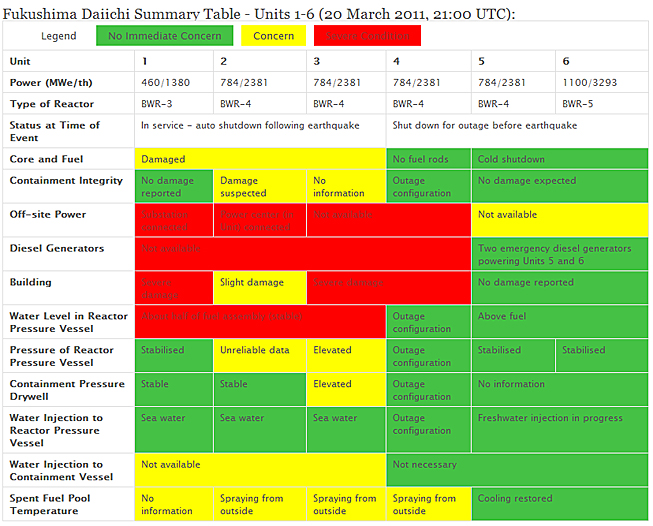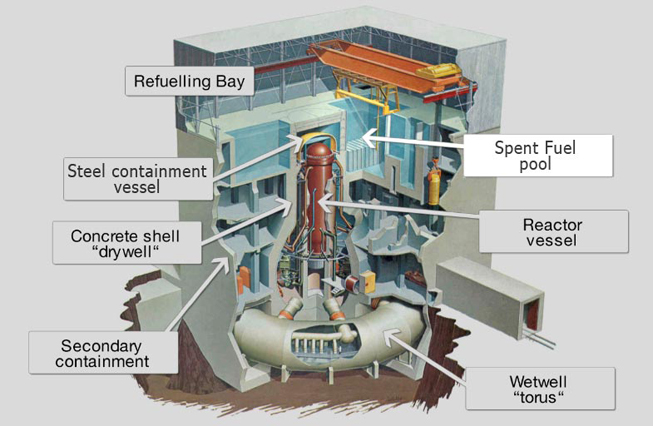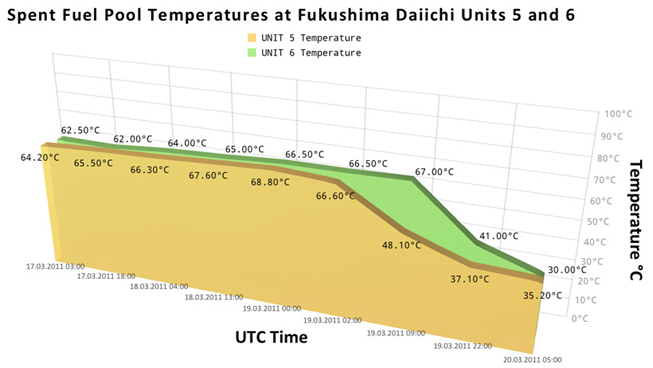→ Chronology of Updates:
2 June | 12-18 May | 4-11 May | 5 May | 3 May | 2 May | 28 April | 27 April | 26 April | 21 April | 20 April | 19 April | 18 April | 15 April | 14 April | 13 April | 12 April | 11 April | 10 April | 9 April | 8 April | 7 April | 6 April | 5 April | 4 April | 3 April | 2 April | 1 April | 31 March | 30 March | 29 March | 28 March | 27 March | 26 March | 25 March | 24 March | 23 March | 22 March | 21 March | 20 March | 19 March | 18 March | 17 March | 16 March | 15 March | 14 March | 13 March | 12 March | 11 March | Full Update
FUKUSHIMA NUCLEAR ACCIDENT UPDATE (20 March 2011, 21:00 UTC)
Summary of Conditions at Fukushima Daiichi Nuclear Power Plant
Located on the Eastern coast of Japan, the six nuclear power reactors at Daiichi are boiling water reactors (BWRs). A massive earthquake on 11 March disabled off-site power to the plant and triggered the automatic shutdown of the three operating reactors - Units 1, 2 and 3. The control rods in those Units were successfully inserted into the reactor cores, ending the fission chain reaction. The remaining reactors - Units 4, 5 and 6 - had previously been shut down for routine maintenance purposes. Backup diesel generators, designed to start up after losing off-site power, began providing electricity to pumps circulating coolant to the six reactors.
Soon after the earthquake, a large tsunami washed over the reactor site, knocking out the backup generators. While some batteries remained operable, the entire site lost the ability to maintain normal reactor cooling and water circulation functions.
Here is the current status of the six reactors, based on documents and confirmed by Japanese officials (new information from 20 March in bold):
Unit 1
Coolant within Unit 1 is covering about half of the fuel rods in the reactor, and Japanese authorities believe the core has been damaged. High pressure within the reactor's containment led operators to vent gas from the containment. Later, an explosion destroyed the outer shell of the reactor building above the containment on 12 March.
There are no indications of problems with either the reactor pressure vessel or the primary containment vessel.
Efforts to pump seawater into the reactor core are continuing.
No precise information has been available on the status of the spent fuel pool.
On 18 March, Japan assigned an INES rating of 5 to this Unit. (See further information on ratings and INES scale).
On 19 March, the containment vessel pressure indication was restored.
Unit 2
Coolant within Unit 2 is covering about half of the fuel rods in the reactor, and Japanese authorities believe the core has been damaged. Following an explosion on 15 March, Japanese officials expressed concerns that the reactor's containment may not be fully intact. As of 19 March, 11:30 UTC, officials could no longer confirm seeing white smoke coming from the building. Smoke had been observed emerging from the reactor earlier.
Efforts to pump seawater into the reactor core are continuing.
No precise information has been available on the status of the spent fuel pool. On 20 March, workers began pumping 40 tonnes of seawater into the spent fuel pool.
On 18 March, Japan assigned an INES rating of 5 to this Unit.
Unit 3
Coolant within Unit 3 is covering about half of the fuel rods in the reactor, and Japanese authorities believe the core has been damaged. High pressure within the reactor's containment led operators to vent gas from the containment. Later, an explosion destroyed the outer shell of the reactor building above the containment on 14 March.
Following the explosion, Japanese officials expressed concerns that the reactor's containment may not be fully intact. White smoke has been seen emerging from the reactor, but on 19 March it appeared to be less intense than in previous days.
Efforts to pump seawater into the reactor core are continuing.
Of additional concern at Unit 3 is the condition of the spent fuel pool in the building. There are indications that there is inadequate cooling water level in the pool, and Japanese authorities have addressed the problem by dropping water from helicopters into the building and spraying water from trucks. Spraying from trucks continued on 20 March. There is no data on the temperature of the water in the pool.
On 18 March, Japan assigned an INES rating of 5 to this Unit.
Unit 4
All fuel from Unit 4 had been removed from the reactor core for routine maintenance before the earthquake and placed into the spent fuel pool. The building's outer shell was damaged on 14 March, and there have been two reported fires - possibly including one in the area of the spent fuel pool on 15 March - that were extinguished spontaneously.
Authorities remain concerned about the condition of the spent fuel pool, and Japanese Self Defence Forces began spraying water into the building on 20 March.
On 18 March, Japan assigned an INES rating of 3 to this site.
Units 5 and 6
Shut down for routine maintenance before the earthquake, both reactors achieved cold shutdown on 20 March. The reactors are now in a safe mode, with cooling systems stable and under control, and with low temperature and pressure within the reactor.
Instrumentation from both spent fuel pools had shown gradually increasing temperatures over the past few days. Officials configured two diesel generators at Unit 6 to power cooling and fresh-water replenishment systems in the spent fuel pools and cores of Units 5 and 6. As of 20 March, temperatures in both pools had decreased significantly.
Workers have opened holes in the roofs of both buildings to prevent the possible accumulation of hydrogen, which is suspected of causing explosions at other units.
Restoration of Grid
Progress has been achieved in restoring external power to the nuclear power plant, although it remains uncertain when full power will be available to all reactors. Off-site electrical power has been connected to an auxiliary transformer and distribution panels at Unit 2. Work continues toward energizing specific equipment within Unit 2.
Evacuation
Japanese authorities have informed the IAEA that the evacuation of the population from the 20-kilometre zone around Fukushima Daiichi has been successfully completed. Japanese authorities have also advised people living within 30 kilometres of the plant to remain inside.
Iodine
On 16 March, Japan's Nuclear Safety Commission recommended local authorities to instruct evacuees leaving the 20-kilometre area to ingest stable (not radioactive) iodine. The pills and syrup (for children) had been prepositioned at evacuation centers. The order recommended taking a single dose, with an amount dependent on age:
| Baby | 12.5 mg |
| 1 mo.-3 yrs. | 25 mg |
| 3-13 yrs. | 38 mg |
| 13-40 yrs. | 76 mg |
| 40+ yrs. | Not necessary |
Radiation Measurements
Radiation levels near Fukushima Daiichi and beyond have elevated since the reactor damage began. However, dose rates in Tokyo and other areas outside the 30-kilometre zone remain below levels which would require any protective action. In other words they are not dangerous to human health.
Dose rates have been provided by Ministry of Education, Culture, Sport, Science and Technology for 47 cities and town representing a comprehensive nationwide monitoring network. The data set covers the period from 15 March, 08:00 UTC to 20 March, 17:00 UTC with an hourly sampling frequency. No significant changes of dose rates have been observed if compared to previous day data.
At the Fukushima Daiichi nuclear plant, radiation levels spiked three times since the earthquake, but have stabilized since 16 March at levels which are, although significantly higher than the normal levels, within the range that allows workers to continue onsite recovery measures. Two new on-site environmental monitoring locations have been added to the monitoring network.
Radionuclides in Foodstuffs and Water
The IAEA has received information from the Japanese Ministry of Health, Labor and Welfare regarding the presence of Iodine-131 in three milk samples tested in the town of Kawamata. The concentration is reported to be above allowed levels. Cesium-137 was detected in one sample, though in concentration below allowed levels.
In the Ibaraki prefecture, Iodine-131 and Cesium-137 have been detected in leaf vegetables such as spring onions and spinach. Some of the samples have been reported to be above the levels allowed by the Japanese food hygiene law for emergency monitoring criteria for intake of vegetables.
According to the Nuclear Safety Division, Ministry of Education, Culture, Sports, Science and Technology (MEXT) analysis for Iodine-131 and Cesium-137 in tap water from 46 locations yielded the majority of samples as non-detects. Only six out of 46 exhibited any iodine-131, though the concentration was reported to be below levels allowed by the Japanese food hygiene law for emergency monitoring criteria for drinking water.

IAEA BRIEFING ON FUKUSHIMA NUCLEAR EMERGENCY (20 March 2011, 15.30 UTC)
Presentations:
→ Technical Briefing on Situation in Japan
→ Watch Video
On Sunday, 20 March 2011, Graham Andrew, Special Adviser to the IAEA Director General on Scientific and Technical Affairs, briefed both Member States and the media on the current status of nuclear safety in Japan. His opening remarks, which he delivered at 15:30 UTC at the IAEA headquarters in Vienna, are provided below:
1. Current Situation
There have been some positive developments in the last 24 hours, but the overall situation at the Fukushima Daiichi nuclear power plant remains very serious.
Efforts to restore electrical power to the site continue. Off-site electrical power has been connected to the local substation for Unit 2 today. Work is continuing under difficult conditions to connect power from the substation to the reactor building. Seawater is still being injected into the reactor pressure vessels of Units 1, 2 and 3. Water injection is not needed for Unit 4 as the reactor is in outage.
White "smoke" or vapour from Unit 3 is still being observed, but it is less intense than on previous days. Spraying of the reactor building with water is in progress.
Following an initial rise in pressure in the Unit 3 reactor pressure vessel, plans were made to vent the vessel should it become necessary. However, from information recently provided by NISA they have decided not to vent as the vessel pressure has started to reduce.
The situation in the reactor spent fuel pools is relatively stable, but is still of concern. Spraying of water into the pool of Unit 4 started yesterday. The Agency still lacks data on water levels and temperatures at the spent fuel pools at Units 1, 2, 3 and 4.
A positive development is that cooling has been restored to the reactor pressure vessels in Units 5 and 6. Temperatures in the spent fuel pools at these two units, which had been rising in the last few days, have now fallen significantly to around 40 degrees centigrade from a maximum of about 69 degrees yesterday. Two diesel generators, one for each Unit, are providing electricity.
2. Radiation Monitoring
Radiation levels in major Japanese cities have not changed significantly since yesterday and remain below those which are dangerous to human health.
The IAEA radiation monitoring team took additional measurements yesterday between Tokyo and locations up to 150 km from the Fukushima site. Dose rates were typically a few microsieverts per hour compared to a typical background level of around 0.1 microsieverts per hour.
From the measurements taken within the exclusion zone, no significant alpha radiation has been detected so far.
This morning, we received additional data from the Agency's monitoring team which indicated contamination on the ground at a location 50 to 70 km from the Fukushima site. The team will make confirmatory measurements tomorrow at the same locations to help validate the initial results. Grass and other samples have also been taken by the team from various locations in the Fukushima Prefecture for analysis. In the coming days, the IAEA monitoring team plans to take measurements at the same locations monitored by the Japanese authorities. This will assist in the validation of measurements. The IAEA is sending additional monitoring experts to Japan to supplement its capabilities in the field.
Some results on the monitoring of foodstuffs have been made available by Japan to the IAEA and FAO. We can confirm measurements indicating that, in some areas, Iodine-131 in milk and in freshly grown leafy vegetables, such as spinach and spring onions, is significantly above the levels set by Japan for restricting consumption of these food products.
3. Agency Activities
The Director General has returned to Vienna and will brief the Board of Governors on Monday on the outcome of his visit to Tokyo.
FUKUSHIMA NUCLEAR ACCIDENT UPDATE (20 March 2011, 16:20 UTC)
Japanese authorities have notified the IAEA of progress at the Fukushima Daiichi nuclear power plant. Workers today have successfully placed reactor Unit 5 (at 05:30 UTC) and 6 (at 10:27 UTC) into cold shutdown.
This means that the reactors are in a safe mode, with cooling systems stable and under control, and with low temperature and pressure within the reactor.
Officials are continuing efforts to restore plant systems at Daiichi Units 1-3.
Unit 4 had been shut down for maintenance, with all its fuel removed from the reactor core, before the 11 March earthquake.
Eight other reactors at the Fukushima Daini, Onagawa, and Tokai nuclear power plants were shut down automatically after the earthquake and all are now in cold shutdown.
FUKUSHIMA NUCLEAR ACCIDENT UPDATE (20 March 2011, 14:00 UTC)
Spent Fuel Pools at Fukushima Daiichi Nuclear Power Plant - Updated
Spent fuel removed from a nuclear reactor is highly radioactive and generates intense heat. This fuel needs to be actively cooled for one to three years in pools that cool the fuel, shield the radioactivity, and keep the fuel in the proper position to avoid fission reactions. If the cooling is lost, the water can boil and fuel rods can be exposed to the air, possibly leading to severe damage and a large release of radiation.
The concern about the spent fuel pools at Fukushima Daiichi is that sources of power to cool the pools have been compromised. (See diagram below for location of the pool in each reactor building.)
Elevated radiation measurements at the site may be partially of the result of uncovered or overheated spent fuel.

Here is a summary of spent fuel conditions at Fukushima Daiichi nuclear power plant, based on documents and confirmed by Japanese officials (new information in bold):
Unit 1
Unit 1 experienced an explosion on 12 March that destroyed the outer shell of the building's upper floors. No precise information has been available on the status of the spent fuel pool.
Unit 2
No precise information has been available on the status of the spent fuel pool. Authorities began adding 40 tonnes of seawater to the spent fuel pool on 20 March.
Unit 3
Unit 3 experienced an explosion on 14 March that destroyed the outer shell of the building's upper floors. The blast may have damaged the primary containment vessel and the spent fuel pool. Concerned by possible loss of water in the pool, authorities began spraying water into the building in an effort to replenish water levels. First, helicopters dropped seawater on 17 March, and every day since then, including today, emergency workers have sprayed water from fire trucks and other vehicles.
Unit 4
This reactor was shut down 30 November 2010 for routine maintenance, and all the fuel assemblies were transferred from the reactor to the spent fuel pool, before the 11 March earthquake. The heat load in this pool is therefore larger than the others.
On 14 March, the building's upper floors were severely damaged, possibly causing a reduction of cooling capability in the spent fuel pool. Emergency workers began spraying water into the building today.
Unit 5 and 6
Instrumentation at these reactors began to indicate rising temperatures at their spent fuel pools starting on 14 March. Three days later, Japanese technicians successfully started an emergency diesel generator at Unit 6, which they used to provide power to basic cooling and fresh-water replenishment systems. Workers created holes in the rooftops of both buildings to prevent any hydrogen accumulation, which is suspected of causing earlier explosions at Units 1 and 3.

A second generator came online on 18 March, and the next day, the higher-capability Residual Heat Removal system recovered full function. Temperatures in the spent fuel pools of Units 5 and 6 have gradually returned to significantly lower temperatures. (See graph at left.)
Common Use Spent Fuel Pool
In addition to pools in each of the plant's reactor buildings, there is another facility - the Common Use Spent Fuel Pool - where spent fuel is stored after cooling at least 18 months in the reactor buildings. This fuel is much cooler than the assemblies stored in the reactor buildings. Japanese authorities have confirmed that fuel assemblies there are fully covered by water, and the temperature was 57 °C as of 20 March, 00:00 UTC.

